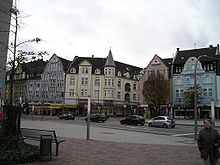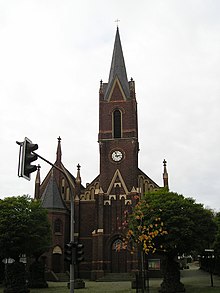Bottrop
Bottrop | |
|---|---|
|
Coat of arms of Bottrop Coat of arms | |
| Country | Germany |
| State | North Rhine-Westphalia |
| Admin. region | Münster |
| District | Urban District |
| Government | |
| • Mayor | Bernd Tischler (SPD) |
| Area | |
| • Total | 100.7 km2 (38.9 sq mi) |
| Elevation | 60 m (200 ft) |
| Population (2022-12-31)[1] | |
| • Total | 118,113 |
| • Density | 1,200/km2 (3,000/sq mi) |
| Time zone | UTC+01:00 (CET) |
| • Summer (DST) | UTC+02:00 (CEST) |
| Postal codes | 46236–46244 |
| Dialling codes | 02041, 02045 |
| Vehicle registration | BOT |
| Website | bottrop.de |



Bottrop (German pronunciation: [ˈbɔtʁɔp] ⓘ) is a city in west central Germany, on the Rhine-Herne Canal, in North Rhine-Westphalia. Located in the Ruhr industrial area, Bottrop adjoins Essen, Oberhausen, Gladbeck and Dorsten. The city had been a coal-mining and rail center and contains factories producing coal-tar derivatives, chemicals, textiles, and machinery. Bottrop grew as a mining center beginning in the 1860s, was chartered as a city in 1921, and bombed during the Oil Campaign of World War II. In 1975 it unified with the neighbour communities of Gladbeck and Kirchhellen, but Gladbeck left it in 1976, leading to Kirchhellen becoming a district of Bottrop as Bottrop-Kirchhellen.
Bottrop has the longest stretch of autobahn without junctions which is often used for testing vehicles at high speed, and is home to the famous Mercedes-Benz tuning company Brabus.
Boroughs
The total area of the municipal territory is about 101 square kilometers. The longest north-south distance is 17 kilometers, and from west to east 9 kilometers. The highest peak within the city's territory is 78 m, the lowest one 26 m above NN.
Bottrop is divided into 3 boroughs, they are: Bottrop-Mitte (Bottrop-Center), Bottrop-Süd (Bottrop South) and Bottrop-Kirchhellen, each one having a borough representation and a borough ruler.
These boroughs are further subdivided into city parts, partly named after their traditional name, while the newly built parts are only recently named :
- Bottrop-Mitte: Eigen, Fuhlenbrock, Stadtmitte (City center)
- Bottrop-Süd: Batenbrock, Boy, Ebel, Lehmkuhle, Vonderort, Gartenstadt Welheim (Garden city Welheim) and Welheimer Mark
- Bottrop-Kirchhellen: Ekel, Feldhausen, Grafenwald, Hardinghausen, Holthausen, Im Loh, Kirchhellen, Kuhberg, Overhagen
For statistical reasons, Bottrop is also divided into statistical boroughs, they are (with their official numbering)
- 11 Altstadt
- 12 Nord-Ost (Northeast)
- 13 Süd-West (Southwest)
- 21 Fuhlenbrock-Heide (Fuhlenbrock-Heath)
- 22 Fuhlenbrock-Wald (Fuhlenbrock-Forest)
|
|
Kirchhellen
From 1919 until 1976 Kirchhellen was its own town. From 1976 until 1978 it was a part of "GlaBotKi"(Gladbeck, Bottrop, Kirchhellen). In 1978 Kirchhellen became part of Bottrop. The Kirchhellner were very angry and today they are still not happy about it.
Most of Kirchhellner are Catholic (approx. 65%) - there are three churches there. There is one Lutheran church (approx. 20% of the population is Lutheran and approx. 5% are Muslims). The rest are mostly without a religion.
Culture and Attractions
Theaters, Museums and Buildings
- Tetraeder, the Tetraeder is a tetrahedron made from steel and residing on concrete pillars. The entire structure is approximately 50m in height and is situated on an 80m high coal mining tip. It has been the town's landmark since its construction in 1995.
- Fire Lookout Post in Grafenwald
- Main Post Office, constructed 1921 bis 1923.
- The Quadrat is a Museum housing permanent exhibitis on local history and displaying works by Josef Albers as well as many temporary exhibitions.
- City Hall (Neo-Renaissance 1910–1916) is regarded as the emblem of the city.
- Alpincenter, the alpincenter is the world's longest indoor ski slope.
- Bodyflying
- Theme Park Movie Park Germany in Bottrop-Kirchhellen
- Schloss Beck theme park and castle (late baroque period 1766–1777)
- Villa Dickmann, constructed 1901–1903 (Art Nouveau)
- Alte Apotheke (Old Pharmacy, Wilhelminian style 1895)
- catholic churches
- Heilige Familie
- Heilig Kreuz, built 1955–57, Windows by Georg Meistermann
- Herz Jesu, built 1929
- Liebfrauen
- St. Antonius
- St. Barbara
- St. Bonifatius
- St. Cyriakus, Propstei, built 1861/62 by Emil von Manger
- St. Elisabeth, built 1954
- St. Franziskus
- St. Johannes Baptist (BOT-Boy)
- St. Johannes der Täufer (BOT-Kirchhellen)
- St. Joseph
- St. Ludger
- St. Mariä Himmelfahrt
- St. Matthias
- St. Michael
- St. Paul
- St. Peter
- St. Pius
- St. Suitbert, built 1955
- Protestant churches[2]
- Auferstehungskirche
- Friedenskirche
- Gnadenkirche
- Martin-Niemöller-Kirche
- Martinskirche, erbaut 1884
- Paul-Gerhardt-Kirche
- Pauluskirche
- Malakow-Turm (1872) of the coal mine Prosper II.
- Coal Mining Tip Haniel with an open air theater (Amphitheater) and the Kreuzweg designed by Tisa von der Schulenburg and Adolf Radecki and opened in 1995.
- Saalbau, convention center
Stolpersteine
Since September 12, 2005 so called „Stolpersteine“ have been placed by artist Gunter Demnig around the city in rememberance of the people deported and then killed by the Nazis mostly in Nazi concentration camps or extermination camps.
Periodic Events
- January: Festival Orgel PLUS (Music festival started in 1989)
- February: Rose Monday Parade and Carnival
- May: Horse Market
- May: Aspargus-Farmer Market in Kirchhellen
- Brezelfest (Pretzel Festival) in Kirchhellen
- May/June/July: Schützenfeste (marksmen festivals) of Bottrops marksmen companies (BSV Bottrop Batenbrock, BSV Bottrop Eigen, BSV Bottrop Fuhlenbrock, BSV Bottrop Vonderort, BSV Andreas Hofer, Alte Allgemeine Bürgerschützengesellschaft, BSV Bottrop Boy) [3][4]
- September: Michaelismarket
Religion
- Catholic: ~50% (19 churches)
- Protestant (Lutheran): ~20% (8 churches)
- Atheist/Agnostic: ~20%
- Muslim: ~5%
Notable people
- Josef Albers (artist and mathematician)
- August Everding (opera director)
- Theo Jörgensmann (jazz musician and composer)
- Ludger Stratmann
- Kelly Trump
- Ulla Kock am Brink
- Da Hool (DJ and music producer)
Attractions
- Alpincenter - Indoor ski slope
- Tetraeder - a 60 m high Tetrahedron, placed on a 90 m slag heap
- Movie Park Germany - theme park (in Bottrop-Kirchhellen)
- Schloss Beck - castle turned into an amusement park (in Bottrop-Kirchhellen)
International relations
Bottrop is twinned with:
 Tourcoing, France, since 1967
Tourcoing, France, since 1967 Blackpool, United Kingdom
Blackpool, United Kingdom Berlin-Mitte, Germany, since 1983 (first with Berlin-Wedding, which fusioned with Berlin-Tiergarten and Berlin-Mitte)
Berlin-Mitte, Germany, since 1983 (first with Berlin-Wedding, which fusioned with Berlin-Tiergarten and Berlin-Mitte) Veszprém, Hungary, since 1987
Veszprém, Hungary, since 1987 Merseburg, Germany, since 1989
Merseburg, Germany, since 1989 Gliwice, Poland
Gliwice, Poland
External links
![]() Media related to Bottrop at Wikimedia Commons
Media related to Bottrop at Wikimedia Commons
References
- ^ "Bevölkerung der Gemeinden Nordrhein-Westfalens am 31. Dezember 2022 – Fortschreibung des Bevölkerungsstandes auf Basis des Zensus vom 9. Mai 2011" (in German). Landesbetrieb Information und Technik NRW. Retrieved 20 June 2023.
- ^ Evangelische Kirchen in Bottrop: http://www.kirchenkreis.org/content/e559/e3019/e2909/index_ger.html
- ^ Past Events of Alte Allgemeine Bürgerschützengesellschaft: http://www.alte-allgemeine.de/termine/eventlist/archive
- ^ Events BSV Bottrop Boy: http://www.turbofilter.de/wp/bsv-boy/termine.html



